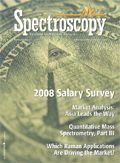2008 Salary Survey: Salaries and Stress Shrink
Spectroscopy staff editor Brian Johnson discusses this year's salaries and trends in employment for spectroscopists.

It's true, the average spectroscopist's salary actually went down in the past year, a surprising development after many years of steady climbing. For the 772 respondents from all walks of the spectroscopy community who took part in this year's salary survey, change hasn't been good.
Before we break down salaries, the following are a few statistics regarding this year's survey:
- The average age of all respondents is 46.7 years. The average age of male respondents is 47.9 years, and females is 41.6 years.
- On average, respondents have 19.9 years of experience in their profession, and 8.3 years of experience in their current position.
- 90% of respondents are employed full-time; 4% are postdoctoral researcher/graduate students; 2% are employed part-time; and 1% are unemployed.
- 17% of respondents are senior scientists/researchers/research fellows; 15% are chemists/spectroscopists; and 15% are laboratory directors/managers.
- 2% of respondents hold associate's degrees; 32% hold bachelor's degrees; 23% hold master's degrees; and 40% hold doctoral degrees.
- 57% of respondents have their highest degree in chemistry and 8% in biology.
- 24% of respondents specialize in applied research/development; 14% in general testing and analysis; and 11% in quality control/assurance validation.
- 59% of respondents' companies offer in-house training.
- Common benefits offered by respondents' companies include 401(k) (75%), retirement plan (62%), and child care (12%).
Salaries Down?
According to this year's survey, the mean salary for all respondents is $77,634, which is down from $79,605 — a decline of $1,971, and even lower than the 2006 average of $77,980 (see Table I). This represents the first downturn in salary we've seen in our annual survey, but some demographic differences might help explain the decrease. One major difference between this year's salary survey and the last is that the percentage of respondents aged under 39 years was up 6% — it was 21% in 2007 and 27% in 2008. This increased number of respondents with less experience and lower salaries definitely did its part to drag the mean salary of the entire respondent group down this year. Along the same lines, there was a 7% increase in respondents who have under 15 years of professional experience in the spectroscopy field — from 32% in 2007 to 39% in 2008.

Table I: 2001â2008 Average salaries
That being said, salaries are still down across the board, as the majority of respondents for this year's survey are reporting lower earnings than last year. In the 2007 salary survey article, it was reported that spectroscopists aged 60 to 64 had a mean salary of $98,319. For 2008, that number went down to $85,953, while respondents over age 65 reported an annual income of $68,681, much less than the $85,733 average income reported last year. However, 27.5% of respondents in the age group of 60 to 64 reported an annual base salary of $100,000 and over. Meanwhile, the average age of survey respondents was 46.7 years, and in that age group, the mean annual base salary for 2008 is $89,873, which is a big improvement over last year's $85,236. So, depending on how you look at it, salaries are down, but it's not as dire as it seems on the surface.
Rounding out the salaries for the different age groups, respondents ages 20 to 24 earn an annual base salary of $33,600; ages 25 to 29 earn $41,344; ages 30 to 34 earn $64,610; ages 35 to 39 earn $71,395; ages 40 to 44 earn $75,955; ages 45 to 49 earn $89,873; ages 50 to 54 earn $81,999; and ages 55 to 59 earn $90,113 (Figure 1).
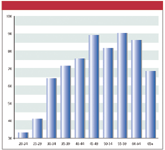
Figure 1: Salary summary by age, 2008.
Males vs. Females
Once again, the gender earnings gap is significantly wide. According to the survey, composed of 75% males and 25% females, males are making $81,481, while females are making significantly less at $65,381, a gap of $16,100, up from $14,218 last year.
A startling finding in our survey was that males earn more than females at all levels of education. At the associate's degree level, males out-earn females $64,000 to $43,000, the largest difference in the study by a startling margin of $21,000. For respondents with bachelor's degrees, males earn $67,479 to $53,446 for females, a difference of $14,033. The gap grows wider again at the master's degree level, with males earning $78,372 and females reporting an income of $60,473, a margin of $17,899. The smallest difference in salary comes at the doctorate level, but males ($94,927) are still far ahead of females ($87,067), a gap of $7,860.
The gender salary gap is also present in each level of professional experience. For respondents with less than 5 years of experience, males out-earned females $47,317 to $42,608 — a difference of $4,709. For those with 5 to 9 years of experience, the gap more than doubles, with males earning $67,689 to $57,390 for females — a rift of $10,299. The subsequent years of experience don't get any better for the gender earnings gap. With 10 to 15 years of experience, it's males $80,001 versus females $70,596 (difference: $9,405); with 16 to 20 years of experience, it's males $89,753 versus females $71,756 (difference: $17,997); with 21 to 35 years of experience, it's males $87,028 versus females $77,169 (difference: $9,859); and with 36 to 40 years of experience, it's males $95,158 versus females $82,750 (difference: $15,408). In other words, it takes females between 36 and 40 years to earn slightly more than males are earning within 10 to 15 years (Figure 2).

Figure 2: Salary gap between males and females at different levels of experience, 2008.
The gap is just as wide when levels of education are taken into account. Of the respondents who are working with an associate's degree, males earn $64,000 while females earn just $43,000. The gap closes a bit with a bachelor's degree, with males earning $67,479 compared to $53,446 for females — but still a large difference of $14,033. Males leap way ahead with a master's degree, raking in $78,372 versus $60,473 for females, giving them an edge of $17,899. When it comes to doctoral degrees, the gap is narrower, but still significant, with males earning $94,927 compared to $87,067 for females — a margin of $7,860 (Figure 3).

Figure 3: Salary gap between males and females at different levels of education, 2008.
Why does such a gap still exist in today's world, where equality is supposed to be the norm? Will this gap ever close, or will it continue to grow? According to David W. Ball, professor of chemistry at Cleveland State University in Ohio, "I certainly hope that the gap closes. The question that this gap brings up is whether it is characteristic of the field of spectroscopy, or whether other technical fields demonstrate the same inequity."
Sectors and Titles
Respondents in the private sector, the largest employer of scientists again this year (60% of respondents) reported an income of $84,173 in 2008, virtually the same as last year's number of $84,831. Scientists working in acedemia (21% of respondents) are making $60,284 this year, down slightly from $61,189 in 2007. Meanwhile, those working in government/national labs (15% of respondents) have an annual base salary of $76,612, up from $74,853 last year (Figure 4).
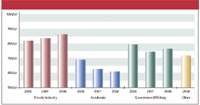
Figure 4: Salary summary by job sector, 2006â2008.
CEOs received a big raise this year, as respondents with the title of CEO/president reported a mean income of $158,833, up from $144,900 in 2007. Technical directors also recieved a boost of over $10,000, reporting a salary of $103,615, up from $93,000 last year. Another increase occurred for those respondents who fall under the category of senior scientist/researcher/research fellow, with a mean income of $97,321, up from $91,041 in 2007. As for job specialties, the highest earners are those in corporate management, with an income of $179,250. Following that are those in production/manufacturing ($84,077), project management ($82,677), and applied research/development ($82,001).
Are You Satisifed?
Satisfaction, stress, and salary have proven once again that they are closely tied together in the professional lives of our respondents. This year's survey revealed that 44% of respondents are extremely or very satisfied with their current position (up from 33.1% last year), 42% are satisfied (up from 36.7% last year), and 14% are not satisfied or not at all satisfied (up from 4.2% last year) (Figure 5). Respondents who claim to be extremely or very satisfied earn a mean of $85,658 in annual base salary, while those who are satisfied earn $73,866, and those who are not satisfied or not at all satisfied earn $64,800.
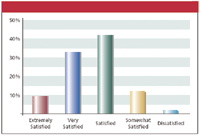
Figure 5: Job satisfaction levels, 2008.
As satisfaction goes up, it appears that stress goes down. For 2008, 48% of respondents say their stress level at work has increased over the past year (down from 52.4% last year), 45% say it is the same (up from 40.7% last year), and 6% say that their stress level has decreased over the past year (up from 4.6% last year). Interestingly, of those respondents who said their stress has increased, 54.1% were women. Among respondents whose stress level has increased, the most common reasons for the increase are staff management uncertainty (45%), business uncertainty (42%), and negative workplace attitudes (40%). For respondents whose stress level has decreased, the most common reasons for the decrease are improved workplace attitudes (48%), more automation through new equipment (21%), and new technology having increased productivity/quality (21%).
As for workload, 62% of respondents say their workload has increased over the past year, 31% say it has decreased, and 6% say it is the same. Among respondents whose workload has increased, the most common reasons for the increase are increased business (56%), staffing cuts (44%), and new equipment added to the lab (38%).
According to our survey, 20% of respondents are considering making a job change in the next year, virtually the same number as last year. For those who are considering a job change, the top reasons for considering a job change are professional advancement (57%), income (53%), and intellectual challenge (38%).
Very Educational
Once again, education is key when it comes to higher earnings. For 2008, spectroscopists who have obtained doctorates (40% of respondents) have a mean salary of $93,525, which is up from $92,600 last year. Respondents at the associate's degree level (2%) also see an increase in annual base salary with $57,000, up from $50,875 in 2007.
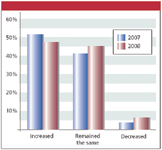
Figure 6: Stress levels, 2007â2008.
However, after touting sharp increases in pay last year, this year respondents who hold bachelor's and master's degrees saw a steep decline in their base salaries. Scientists with bachelor's degrees (32%) experienced a drop from $68,292 in 2007 to $63,670 in 2008, a plunge of $4,622 and the first decrease since 2005. Respondent's with master's degrees (23%) experienced a similar plummet, earning $73,341 in 2008, down $4,342 from the 2007 salary of $74,639.
The Southwest Rises Again
For the second year in a row, the Southwest (where 16% of respondents live) is the region with the highest average salary, earning an annual income of $89,049, slightly down from $89,735 last year. This year, the Midwest (29% of respondents) earned the least, with $70,040, down from $71,820 in the previous survey. Last year's lowest salary region, the Northwest (5% of respondents), earned $73,135, which is up from $67,306 in 2007.
Narrowly above the Northwest is the Southeast (16% of respondents), with $73,993 in annual base salary, a big decline from $79,700 last year. The Northeast (26% of respondents) earns second-place honors again this year, with $82,926, slightly up from $82,040 in 2007 (Figure 7).

Figure 7: Salary summary by geographical location, 2008.
The data presented in this article are a small sampling of the spectroscopy community as a whole. If you would like to share your thoughts on this article and its data, and how it relates to your career, please e-mail us at: spectroscopyedit@advanstar.com
Methodology
The 2008 Spectroscopy Salary Survey was designed by the corporate research department with the assistance of Spectroscopy. A link for the online survey was sent to the entire circulation list of Spectroscopy. The invitation was successfully sent to 20,481 subscribers. A total of 772 individuals responded, for a response rate of 3.8%. The field time of the survey was January 9, 2008, through January 23, 2008. To encourage participation, all subscribers who responded to the survey were entered into a drawing to win one of five $100 gift cards. Maximum Statistical Error @ 95% Confidence Level: +/– 3.6%.
